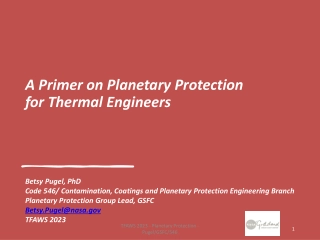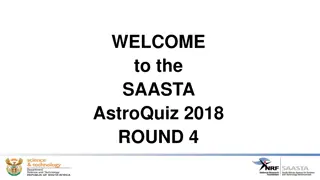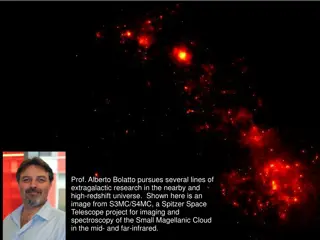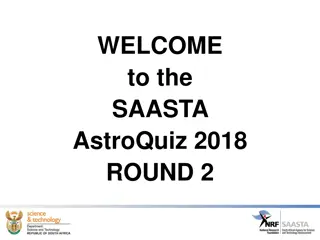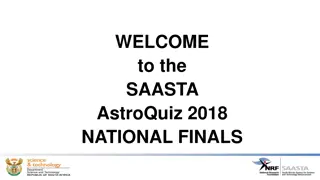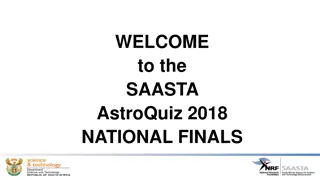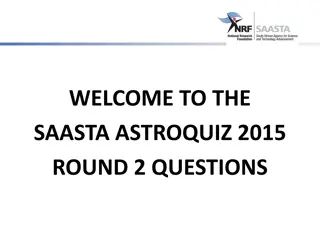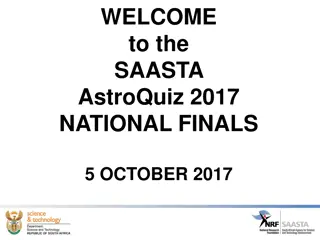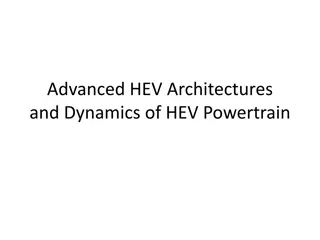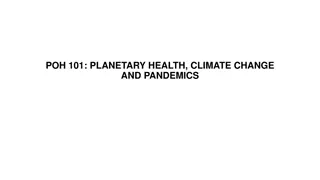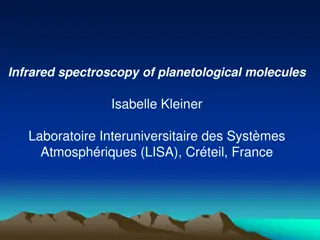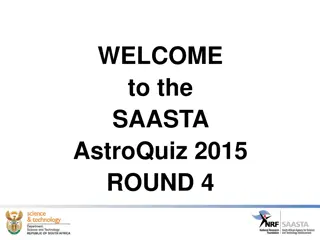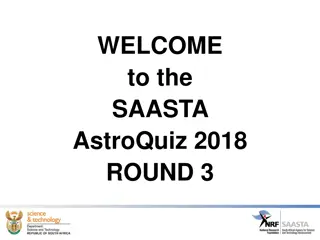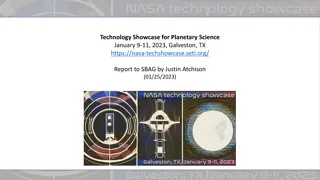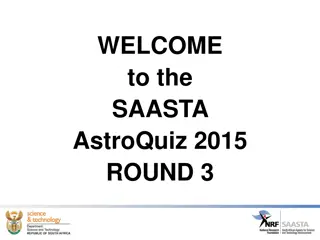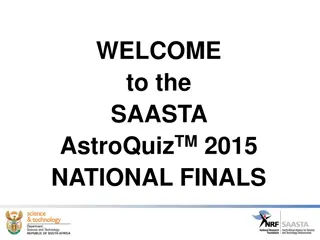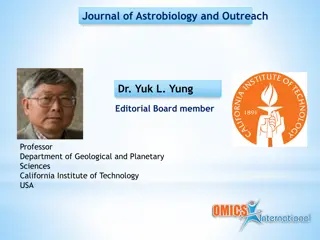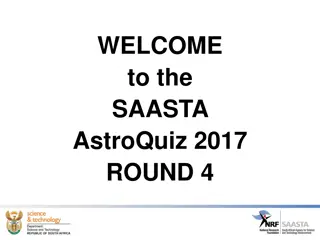SAASTA AstroQuiz 2017 Round 3: Planetary Knowledge Challenge
Participate in the SAASTA AstroQuiz 2017 Round 3 and test your planetary knowledge with a series of questions related to various celestial bodies. You have 60 seconds to answer each question. Use the provided image for reference and enjoy the space-themed quiz! Remember, no internet or cellphones allowed!
Download Presentation

Please find below an Image/Link to download the presentation.
The content on the website is provided AS IS for your information and personal use only. It may not be sold, licensed, or shared on other websites without obtaining consent from the author.If you encounter any issues during the download, it is possible that the publisher has removed the file from their server.
You are allowed to download the files provided on this website for personal or commercial use, subject to the condition that they are used lawfully. All files are the property of their respective owners.
The content on the website is provided AS IS for your information and personal use only. It may not be sold, licensed, or shared on other websites without obtaining consent from the author.
E N D
Presentation Transcript
WELCOME to the SAASTA AstroQuiz 2017 ROUND 3
RULES You only have 60 seconds to answer the questions. You are allowed to discuss amongst yourselves. Calculators may be used if needed. No internet is to be used, therefore the use of cellphones is also prohibited. The judge s decision is final.
PLEASE PRINT THIS PICTURE WITH COLOUR AND LET THE LEARNERS USE IT TO ANSWER QUESTIONS 1 10.
QUESTION 1 The planet represented in Picture 1 has more than one moon. A. True B. False
QUESTION 2 This planet, represented in Picture 1, is found beyond the Kuiper belt. A. True B. False
QUESTION 3 This planet, in Picture 1, is ______ A. B. C. D. Bigger than Saturn and smaller than Neptune Bigger than Earth and smaller than Neptune Bigger than Earth and smaller than Saturn Bigger than Jupiter but smaller than Earth
QUESTION 4 Whereas Earth is tilted at an angle of 23,5 degrees from its vertical, this planet is tilted by approximately ______ from its vertical. A. 45 degrees B. 25,3 degrees C. 54 degrees D. 90 degrees
QUESTION 5 The most abundant gases in this planet s are ____ A. Hydrogen and Methane B. Hydrogen and Helium C. Hydrogen and Lithium D. Hydrogen and Oxygen
QUESTION 6 One of the moons on this planet is approximately half the size of the Earth s moon. A. True B. False
QUESTION 7 The largest moons on this planet in Picture 1 are named after characters in the play A midsummer Night s dream . A. True B. False
QUESTION 8 Each half of the planet on Picture 1 experiences a 21-year-long winter. A.True B. False
QUESTION 9 While the other planets look like spinning tops as they make their journey around the Sun, this planet is flipped on its side when it goes around the Sun. A. True B. False
QUESTION 10 What is the name of this planet represented in Picture 1? A. B. C. D. Mars Earth Uranus Neptune
QUESTION 11 How many hexagonal elements are there in SALT s primary mirror? A. 91 B. 57 C. 80 D. 100
QUESTION 12 What is the name of the Australian Square Kilometre Array forerunner? A. Pathfinder B. Explorer C. MeerKAT D. KAT-7
QUESTION 13 What does the acronym for the space probe COBE stand for? A. Cosmic Background Explorer B. Centre Of Basic Exploration C. Centre Of Basic Education D. Cosmic Behind Explorers
QUESTION 14 What is the heaviest element to form in the core of a massive star? A. Iron B. Gold C. Diamond D. Steel
QUESTION 15 What is the average Earth Moon distance? A. 384 000 km B. 364 000 km C. 384 000 m D. 364 000 m
QUESTION 16 Which amongst the following is the smallest dwarf planet? A. Ceres B. Eris C. Pluto D. Makemake
QUESTION 17 How many days are there between the waxing quarter and waning quarter Moon? A.29 B. 30 C. 14 D.31
QUESTION 18 What is the largest moon in the solar system? A.Ganymede B. Titan C. Europa D.Io
QUESTION 19 What planet in the solar system has its axis of rotation almost in the plane of the ecliptic? A. Saturn B. Jupiter C. Mars D. Uranus
QUESTION 20 What is the name of the South African Square Kilometre Array forerunner? A. Pathfinder B. Explorer C. MeerKAT D. SKA
QUESTION 21 How long does it take the reflected sunlight to reach us from the Earth s Moon? A. 8 minutes B. 1 hour C. 1 seconds D. 1 minute
QUESTION 22 Why do we not have lunar or solar eclipses every month? It is because ______ A. We cannot see the Moon everyday of the month B. The Earth's orbit around the Sun is not in the same plane as the Moon's orbit around the Earth C. Of the speed at which the Moon is orbiting the Earth D. Of the speed at which the Earth is orbiting the Moon
QUESTION 23 Around which planet in the solar system can we find the smallest moon? A. B. C. D. Saturn Jupiter Mars Uranus
QUESTION 24 Around which planet would you find the largest moon in the solar system? A. B. C. D. Saturn Jupiter Mars Uranus
QUESTION 25 On which planet in the solar system would you find the largest volcano? A. B. C. D. Saturn Jupiter Mars Uranus
QUESTION 26 The second nearest star to us after the Sun is Proxima Centauri. What is the third nearest star to us? A. Barnard s Star B. Sirius C. Antares D. Alpha Centauri
QUESTION 27 Sputnik 1 was the first artificial satellite ever to be launched into space. When did this happen? A. 4 October 1957 B. 12 April 1961 C. 4 December 1957 D. 16 June 1963
QUESTION 28 What was the name of the first US satellite to be launched into space? A. B. C. D. Explorer 1 SUNSAT Sputnik 1 Salyut 1
QUESTION 29 What was the name of the first South African satellite to be launched into space? A. B. C. D. Explorer 1 SUNSAT Sputnik 1 Salyut 1
QUESTION 30 Of the 5 officially recognised dwarf planets in our solar system, Pluto is the largest, followed by _ A. B. C. D. Eris, Haumea, Makemake, Ceres Eris, Makemake, Haumea, Ceres, Eris, Haumea, Makemake, Ceres Eris, Ceres, Makemake, Haumea,
THANK YOU FOR PARTICIPATING


![❤[PDF]⚡ Planetary Ring Systems (Springer Praxis Books)](/thumb/21506/pdf-planetary-ring-systems-springer-praxis-books.jpg)
